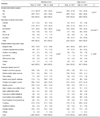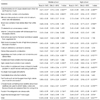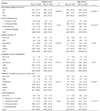Abstract
Objectives
This study attempted to compare adolescents' dietary behaviors and perceptions by gender in order to recommend useful strategies for nutrition interventions.
Methods
Subjects were 2,363 middle school (MS) and high school (HS) students. They completed a self-administered questionnaire on their interest in diet and health, dietary perceptions, nutrition knowledge, dietary practices, and dietary environment at home. Data were analyzed using t-test, χ2-test, and simple regression analysis by gender and by school groups.
Results
Overall, girls obtained higher scores than boys did for "interest" (MS: p<0.001; HS: p<0.01), "dietary perceptions" (MS: p<0.001; HS: p<0.01), and "knowledge" (MS: p<0.01; HS: p<0.001). Regarding "dietary practices," no gender differences were observed among MS students, however, among HS students, boys obtained higher scores-reflecting good practices-than girls did (p<0.01). In all subjects, dietary environment at home was strongly associated with dietary practice than other variables (MS boys: β=0.435, p<0.001; MS girls: β=0.492, p<0.001, HS boys: β=0.271, p<0.001; HS girls: β=0.429, p<0.001).
Conclusions
We observed gender differences in some of the variables such as knowledge and perception among adolescent students. Educational programs and core strategies that consider these gender differences need to be developed. Specifically, for girls, educational programs should focus on facilitating dietary recommendation adherence, whereas for boys, the program could focus on improving dietary knowledge and perceptions.
Figures and Tables
Acknowledgments
This research was supported by a grant from the Ministry of Food and Drug Safety (14162MFDS130).
References
1. Golmakani N, Naghibi F, Moharari F, Esmaily H. Health promoting life style and its related factors in adolescent girls. J Midwifery Reprod Health. 2013; 1(1):42–49.
2. Spratt J, Shucksmith J, Philip K, Watson C. Part of who we are as a school should include responsibility for well-being: links between the school environment, mental health and behavior. Pastor Care Educ. 2006; 24(3):14–21.
3. Sung CJ. A comparative study of food habits and body satisfaction of middle school students according to clinical symptoms. J Korean Soc Food Sci Nutr. 2005; 34(2):202–208.
4. Lee JS, Yun JW. A study on perception about body image, dietary attitude, dietary self-efficacy and nutrient intake of high school students in Busan. J Korean Soc Food Sci Nutr. 2003; 32(2):295–301.
5. Ministry of Health and Welfare, Korea Centers for Disease Control and Prevention. Korea Health Statistics 2014 Korea National Health and Nutrition Examination Survey (KNHANES VI-2) [internet]. Ministry of Health and Welfare Korea Centers for Disease Control and Prevention;2015. cited 2016 Jan 10. Available from: http://knhanes.cdc.go.kr/.
6. Ministry of Education, Science and Technology, Ministry of Health and Welfare, Korea Centers for Disease Control and Prevention. 2015 Korean Youth Risk Behavior Web-based Survey [internet]. Ministry of Health and Welfare Korea Centers for Disease Control and Prevention;2015. cited 2015 Dec 29. Available from: http://knhanes.cdc.go.kr/.
7. Lee YS, Lim HS, Ahn HS, Jang NS. Nutrition through the life cycle. Seoul: Kyomunsa;2011. p. 281.
8. Jo JE, Park HR, Jeon SB, Kim JS, Park GE, Li Y. A study on relationship between socio-demographic factors and food consumption frequencies among adolescents in South Korea. Korean J Community Nutr. 2013; 18(2):165–176.
9. Croll JK, Neumark-Sztainer D, Story M. Healthy eating: what does it mean to adolescents? J Nutr Educ Behav. 2001; 33(4):193–198.
10. Diaz H, Marshak HH, Montgomery S, Rea B, Backman D. Acculturation and gender: influence on healthy dietary outcomes for Latino adolescents in California. J Nutr Educ Behav. 2009; 41(5):319–326.
11. Kwak SH, Woo TJ, Lee KA, Lee KH. A comparison of dietary habits and influencing factors for vegetable preferences of adolescents in Gyeongnam province. Korean J Community Nutr. 2015; 20(4):259–272.
12. Bisogni CA, Jastran M, Seligson M, Thompson A. How people interpret healthy eating: contri-butions of qualitative research. J Nutr Educ Behav. 2012; 44(4):282–301.
13. Yang IS, Lee HY, Kim HY, Kang YH. Setting instructional goals for nutritional education program through an analysis of problems identified in junior/senior high school students. Korean J Community Nutr. 2003; 8(4):495–503.
14. Park SH, Park HR, Jeon SB, Jeong SY, Tserendejid Z, Seo JS. Awareness and practice of dietary action guide for adolescence among middle and high school students in Korea. Korean J Community Nutr. 2012; 17(2):133–145.
15. Contento IR. Nutrition education: linking research, theory and practice. 3th ed. Massachusetts: Jones & Bartlett Learning;2015. p. 65–66. p. 74p. 78–79. .
16. Chang HS, Roh SM. Comparison with dietary habits, dietary attitudes and nutritional knowledge according to sex of teenagers in Jeonnam province. Korean J Community Nutr. 2006; 11(4):459–468.
17. Ministry of Health and Welfare. Dietary guidelines for Korean [internet]. Ministry of Health and Welfare;cited 2014 Jan 20. Available from: http://www.mohw.go.kr/front_new/.
18. Lee EJ. A survey on the snack intake and dietary habits affected by nutrition knowledge of middle school students in Incheon [master's thesis]. Inha University;2012.
19. Kim MN. Adolescent's dietary behaviors, health interest, nutrition knowledge: Its effects on their intakes of nutritional supplements [master's thesis]. Hanyang University;2013.
20. Dewar DL, Lubans DR, Plotnikoff RC, Morgan PJ. Development and evaluation of social cognitive measures related to adolescent dietary behaviors. Int J Behav Nutr Phys Act. 2012; 9(36):1–10.
21. Park KS, Chun BY, Kam S, Yeh MH, Kang YS, Kim KY. Structural relationships among health concern, health practice and health status of the disabled. Korean J Prev Med. 1999; 32(3):276–288.
22. Breslow L, Enstrom JE. Persistence of health habits and their relationship to mortality. Prev Med. 1980; 9(4):469–483.
23. Lee YJ, Lee HJ, Lee KH. Effects of 16-class nutrition education on middle school students' dietary behavior and nutritional knowledge. Korean J Food Nutr. 2014; 27(5):826–836.
24. Kang NE, Yoon HR, Kim JH. A Study on the behavior of food hygiene and interest in dietary information according to the level of awareness and practice of food safety. Korean J Food Cult. 2013; 28(6):623–630.
25. Jung YH, Ko SJ, Lim HJ. The socioeconomic cost of adolescent obesity. Health Soc Welf Rev. 2010; 30(1):195–219.
26. Sung EJ, Shin TS. The effect of overweight to cardiovascular risk factors among Korean adolescents. J Korean Acad Fam Med. 2003; 24(11):1017–1025.
27. Voelker DK, Reel JJ, Greenleaf C. Weight status and body image perceptions in adolescents: current perspectives. Adolesc Health Med Ther. 2015; 6:149–158.
28. Ahn Y, Kim KW. Beliefs regarding vegetable consumption, selfefficacy and eating behaviors according to the stages of change in vegetable consumption among college students. Korean J Community Nutr. 2012; 17(1):1–13.
29. Choi MK, Bae YJ, Kim MH, In SJ. A survey of the needs of nutrition education based on analysis of eating habits and nutrition knowledge among middle school students in Kyung-Gi province. J Korean Diet Assoc. 2010; 16(2):133–145.
30. Choi MY, Kim HY. Nutrition knowledge, dietary self-efficacy and eating habits according to student's stage of regular breakfast or exercise. Korean J Community Nutr. 2008; 13(5):653–662.
31. Kim YH. A survey on the nutrition knowledge, dietary behavior and satisfaction of dietary education of high school female students. J Korean Home Econ Educ Assoc. 2012; 24(1):21–36.
32. Schwartz NE. Nutritional knowledge, attitudes and practices of high school graduates. J Am Diet Assoc. 1975; 66(1):28–31.
33. Kim BH, Sung MY, Lee YN. Comparison of the nutrient intakes by the score of dietary action guides for Korean children among the elementary school students in Gwangju city. Korean J Community Nutr. 2011; 16(4):411–425.




 PDF
PDF ePub
ePub Citation
Citation Print
Print










 XML Download
XML Download